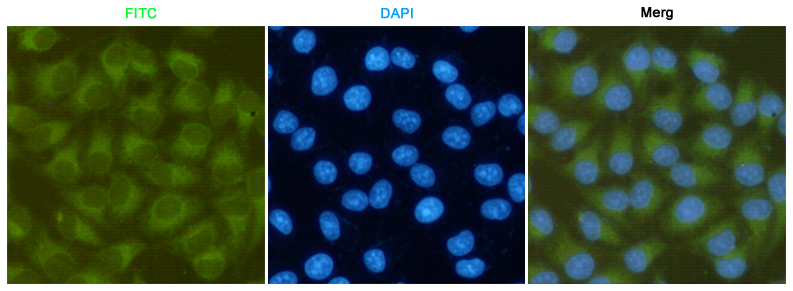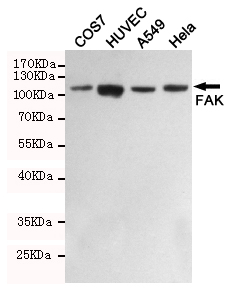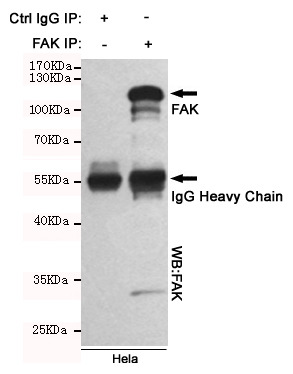-
Product Name
Anti-FAK (3D8) Mouse antibody
- Documents
-
Description
FAK (3D8) Mouse monoclonal antibody
-
Tested applications
WB, ICC/IF, IP
-
Species reactivity
Human
-
Alternative names
FADK 1;FADK;FAK 1;FAK 1;FAK related non kinase polypeptide;FAK1;FAK1_HUMAN;Focal adhesion kinase 1;Focal adhesion kinase 1;Focal adhesion Kinase;Focal adhesion kinase isoform FAK Del33;Focal adhesion kinase related nonkinase;FRNK;p125FAK;pp125FAK;pp125FAK antibody
-
Isotype
IgG1
-
Preparation
Antigen: Purified recombinant human FAK protein fragments expressed in E.coli.
-
Clonality
Monoclonal
-
Formulation
PBS(pH 7.4) containing with 0.03% Proclin300 and 50% glycerol.
-
Storage instructions
Store at 4°C short term. Store at -20°C long term. Avoid freeze / thaw cycle.
-
Applications
WB: 1/1000
;ICC: 1/200
-
Validations

Immunofluorescent analysis of Hela cells fixed fixed by anhydrous methanol at -20u2103 and using FAK mouse mAb (dilution 1:200).

Western blot detection of FAK in COS7,HUVEC,A549 and Hela cell lysates using FAK mouse mAb (1:1000 diluted).Predicted band size: 125KDa.Observed band size:125KDa.

Immunoprecipitation analysis of Hela cell lysates using FAK mouse mAb.
-
Background
Swiss-Prot Acc.Q05397.Non-receptor protein-tyrosine kinase implicated in signaling pathways involved in cell motility, proliferation and apoptosis. Activated by tyrosine-phosphorylation in response to either integrin clustering induced by cell adhesion or antibody cross-linking, or via G-protein coupled receptor (GPCR) occupancy by ligands such as bombesin or lysophosphatidic acid, or via LDL receptor occupancy. Plays a potential role in oncogenic transformations resulting in increased kinase activity.
Related Products / Services
Please note: All products are "FOR RESEARCH USE ONLY AND ARE NOT INTENDED FOR DIAGNOSTIC OR THERAPEUTIC USE"
